

![]()
BORDER COLLIE COUSINS
THE OLD ENGLISH SHEEPDOG
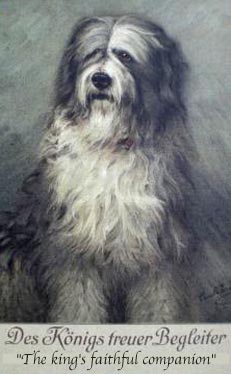
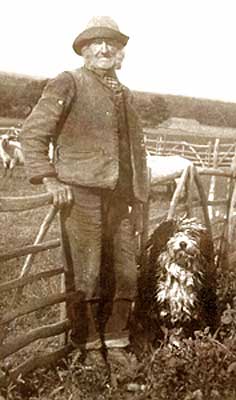 Right, "a Cotswold shepherd with a Bearded Collie, c. 1890." (Old Farm Dogs by David Hancock, Shire Publications, 1999.)
Right, "a Cotswold shepherd with a Bearded Collie, c. 1890." (Old Farm Dogs by David Hancock, Shire Publications, 1999.)
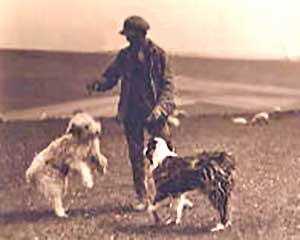 Left, a shepherd on the English Downs in 1937 plays with his two sheepdogs, one an Old English type, the other more a Border Collie type.
Left, a shepherd on the English Downs in 1937 plays with his two sheepdogs, one an Old English type, the other more a Border Collie type.
After giving it careful thought, we've decided to include the Old English Sheepdog among the Border Collie cousins. Linda Rorem says that the Old English Sheepdog is generally not considered a collie breed "because of two things--the association of the collie with Scotland (and northern England), and the early development of the Collie and Old English Sheepdogs as [separate] show breeds. [However] I think," she says, "there is a relationship."
Rorem goes on to say:
In older accounts, variants of coat type were often associated with "curs" as opposed to "shepherds' dogs" (re: Bewick). These variations were present in southern England, but the type was even more variable. Apparently the smooth [collie-type] coats and shaggy [OES-type] coats were more common in England than the longhaired [collie-type] coats, but there must have been longhaired coats there as well. When dog shows began to be held, the Rough Collie and Smooth Collie were among the earliest sheepdogs developed as "breeds". Similar smooth-coated and long-coated dogs could be found in southern England and Wales, but since the "Collie" was already established as a "breed", it was the shaggy dog that was taken up as the "English Sheepdog".
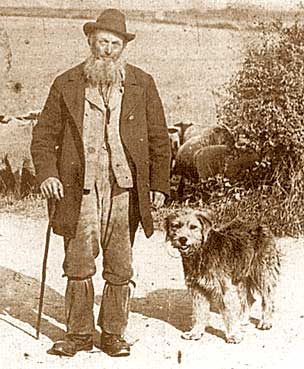 Right, a shepherd from Oxforshire with a "farm dog [that] represents the type that became known as the 'Blue Shag' in Hampshire." (Ibid.)
Right, a shepherd from Oxforshire with a "farm dog [that] represents the type that became known as the 'Blue Shag' in Hampshire." (Ibid.)
It was pointed out earlier (on the top Collie Cousins page) that, in their study of a mutation that caused sensitivity to certain drugs, Mark W. Neff, et al, found that the Collie, the Australian Shepherd, the Shetland Sheepdog, the English Shepherd, the McNab, and the Old English Sheepdog all shared the mutation. The Border Colle, the Bearded Collie, and the Australian Cattle Dog did not. This means, they concluded, that the breeds that carry this mutation "share a common ancestor," and they proposed that "this animal lived in Great Britain in the 1800s before the emergence of formal breeds." This does not mean that the breeds that don't carry the mutation are not related to the ones that do; it only means that their relationship goes back to before the gene mutated. It does, however, definitively relate the Old English Sheepdog to the other collie breeds that share the mutation, and we can safely say that the Old English Shepherd is indeed a collie cousin.
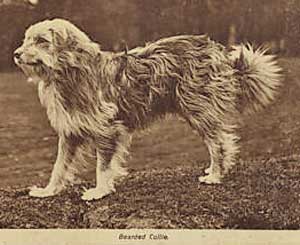 A working Bearded Collie, not that much different from the working OES. It appears to be somewhat longer in the body, as most collies are, with a slightly longer coat and less hair on the legs and face.
A working Bearded Collie, not that much different from the working OES. It appears to be somewhat longer in the body, as most collies are, with a slightly longer coat and less hair on the legs and face.
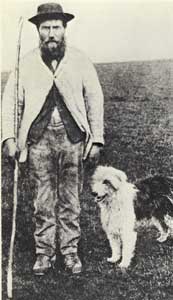 Right, a 1860 photo of a shepherd "and his Bobtailed sheepdog, showing the classic colouring of the breed but still featuring a much less heavy coat than the breed shows today." (Old Working Dogs by David Hancock, Shire Publications 1984.)
Right, a 1860 photo of a shepherd "and his Bobtailed sheepdog, showing the classic colouring of the breed but still featuring a much less heavy coat than the breed shows today." (Old Working Dogs by David Hancock, Shire Publications 1984.)
In his book, Animal Drawing and Anatomy (Scribner, 1928), John Edwin Noble (1876-1961), an English painter and illustrator, described how the Old English Sheepdog probably came to be a bobtailed dog:
A powerful dog...was very necessary to the serfs to protect the flocks and herds from attacks of wolves, etc., and these [dogs] were marked by "tawing"[*] or cutting off three toes. This so interfered with their running that the tail was substituted for the toes, and it is possible that the Sussex Bobtail Sheepdog is a direct descendant of these, and has by selection become a tailless breed. The mark or badge denoting a Sheepdog has until quite recent years remained as a tailless dog, such being exempt from licence duties...
[*Note: in this context, the word "tawing" is taken to mean "toe-ing" or cutting off of toes; however, the word is usually used in a context of tanning or preparing hides or skins for tanning.]
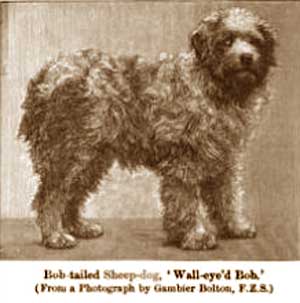 Left, a "Bob-tail Sheepdog" from one of the Chambers Encyclopaedias, of which there were many editions throughout the 19th century.
Left, a "Bob-tail Sheepdog" from one of the Chambers Encyclopaedias, of which there were many editions throughout the 19th century.
In old photos it is sometimes difficult to distinguish among the various strains of shaggy-coated sheepdogs, the biggest differences being, perhaps, lack of a tail, the length of the coat, or the length of the body (the distance between the front legs and the back legs). The OES resembled the Bearded Collie and several other breeds or types that are now extinct, like the Smithfield collie or sheepdog, and the Welsh Grey. We have tried to include some of them here for comparison. We have also seen (particularly on the Barclay Wills page) that many old shepherds by the middle of the 19th century, had both an OES and a Border Collie-type dog, and that Wills mentioned that "there was also a distant[ly related] breed of Sussex sheep dog, smaller than the Old English and brown in colour." It would not be inappropriate, I think, to say that the Old English Sheepdog as a working dog is probably extinct today. The Bearded Collie as a working dog still exists in Scotland, but it bears little resemblance to the Bearded Collies seen at shows.
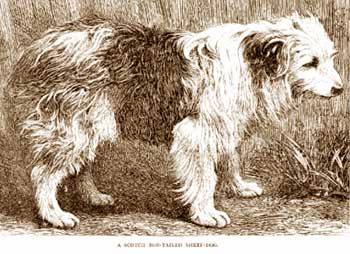 Left, a drawing from The Illustrated Book of the Dog by Vero Shaw.
Left, a drawing from The Illustrated Book of the Dog by Vero Shaw.
Vero Kemball Shaw (ca. 1858-1921), a 19th and early 20th century British writer and illustrator, was a prolific author of books on dogs, and contributed to the Kennel Club standards for numerous breeds because his illustrations were considered accurate likenesses and his writing considered accurate descriptions. However, the illustration at left, labled "A Scotch Bob-tailed Sheep-Dog" seems to confuse (or rather, to fuse) the Bob-tail or English Sheepdog with the Bearded Collie. Like many "show people" of his day, he ranked dogs by degree of "aristocracy", and of the Bob-tailed Sheep-Dog he said "his homely and rugged exterior place his claims to aristocratic patronage beneath those of the ordinary Collie."
Interestingly enough, I heard from Shaw's granddaughter in Australia, Esther Vere Shaw Martin, who wrote to correct the dates I had for Shaw. Apparently, there were two Vero Kemball Shaws, cousins. It was the elder of the two, Ms Martin's great uncle, who died in 1905 without issue. Ms Martin says her grandfather "was a widower who remarried very late in life...His wife died in 1919, leaving a four year old child, my mother. He died a few short years later in 192[1]. My mother was then brought up by her extended family, and knew very little about her immediate family." Ms Martin is currently doing research on her family background.
Shaw quoted R. J. Lloyd Price (of Bala, the man credited with organizing the first sheepdog trial in 1873) as saying that the bob-tail sheepdogs "come principally from the Lake Country." However, Shaw did not seem to agree with this assessment of their origin. He preferred an origin in areas where he had seen them in "fair numbers" at shows, like Exeter in Devon, in the southwest of England. In this he was not too far off the mark. There seemed to be, however, some confusion in his mind between the Bob-tail and the Bearded Collie, as he pointed out "It is...singular that a very similar variety appears to be known in Scotland, where it is sometimes termed the 'Rough-coated' Collie, from the shagginess of its jacket." He went on to say that "the strong resemblance in many points of the English bob-tailed dog is too striking to be accidental, and it is hardly likely that there were two original types; but whether the northern or southern type was that original cannot now be decided." It is difficult to dismiss someone who has had so much experience observing dogs, and indeed, as we have seen from the earliest photos, it is not easy to distinguish among the large variety of shaggy shepherd's dogs. On the other hand, his experience was with the early show dogs and not necessarily with the actual working dogs.
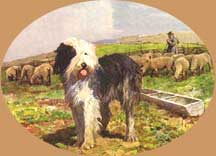
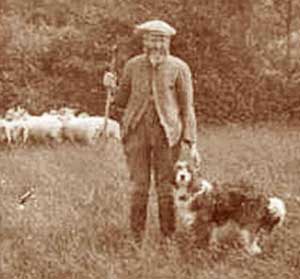
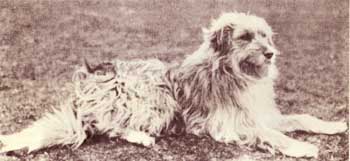 Left, a Sussex Shepherd with a Bearded Collie (from the mid-20th century).
Left, a Sussex Shepherd with a Bearded Collie (from the mid-20th century).
Right, "the old working type of Bearded Collie, used extensively as a drover's dog and Scotland's equivalent of the Bobtailed Sheepdog." (Old Working Dogs by David Hancock, Shire Publications, 1984.)
In his two very excellent books for Shire Publications, Old Working Dogs (1984) and Old Farm Dogs (1999), David Hancock bemoaned the fact that many types of shepherd's dogs that were once extant throughout Britain had vanished. "The modern list of Kennel Club recognised pedigree breeds," he said, "bears no relation to the rich heritage of local variety once found in British pastoral dogs." Dogs he mentioned that resembled the Old English Sheepdog and are now extinct included the Old Welsh Grey, the Sussex Bobtail, the Smithfield, and the old working type of Bearded Collie. He called them "goat-haired sheepdogs" and he said they "illustrate how coat length and texture, size and working style developed out of the farmer's needs."
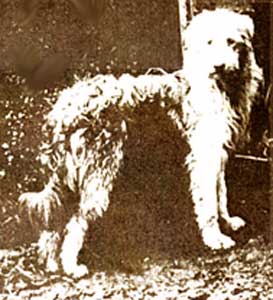 Left, one of Hancock's "goat-haired sheepdogs." (Ibid.)
Left, one of Hancock's "goat-haired sheepdogs." (Ibid.)
Adelaide L. J. Gosset (Shepherds of Britain, Constable & Co, 1911), in an article entitled "The Old English or Sussex Sheep-Dog" said of this type:
The Southdown shepherds seem to prefer these dogs to the collie. They are "not so highly intelligent, but feel the heat less," and are less "meek." A Portland landowner describes his sheep-dogs as "shaggy, with a great deal of woolly hair over the face and eyes, as in the face of the poodle; bluish-grey and white in colour, with stumpy tails, and very intelligent." These dogs are noted for showing a devotion to their master and his family, to the exclusion of all others, as Mr. W. H. Hudson has recorded.
Right, "The Old Welsh Grey, now extinct, a much valued old breed of shepherd's dog. With a harsh weatherproof coat and easy to train, they were used with cattle also and excelled in harsh conditions. (Old Working Dogs by David Hancock, Shire Publications, 1984.)
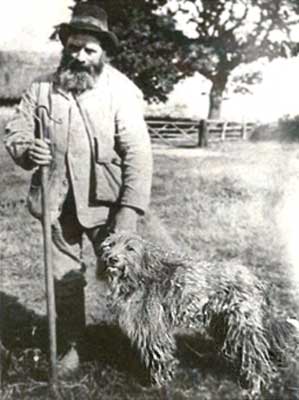 Right, "a shepherd in Norfolk in 1923 with his Smithfield Sheepdog, a type now lost, but still cropping up in lurchers." (Ibid.)
Right, "a shepherd in Norfolk in 1923 with his Smithfield Sheepdog, a type now lost, but still cropping up in lurchers." (Ibid.)
Gosset conveyed a story told to her by one of her "correspondants" which may give some insight into one of the ways that the Old English (or what was then called the Sussex sheep-dog) may have worked:
[My father] was very proud of his old Sussex sheep-dog, and there was great rivalry between him and another shepherd, who declared that none could beat his own dog in shepherding.
It was sheep-washing [and] the sheep refused to go over the bridge across the stream which led to the pen. At first both dogs failed to manage them, for they evaded the bridge in every possible way. "Ah!" said the Scotsman, "your dog is not so clever after all." But, [my father] said, "I have not told Nimble to mount up yet." Nimble had this order given him, and at once jumped on to the backs of the flock, running over the compact mass of woollens and snapping at their ears. In five minutes the three hundred sheep were over the bridge and penned ready for their wash.
The Scotsman had to acknowledge his dog beaten. He was more accustomed to the use of a collie, which dogs do not manage their shepherding in this fashion...
Vero Shaw (The Illustrated Book of the Dog) confirmed this way of working with a quote from R. J. Lloyd Price, but said "[The] allusion...to the bob-tailed dog running over the backs of sheep has, to a certain extent, surprised us. We know the practice is a common one amongst Sheep-dogs, but should have considered the breed in question too heavy a build to resort to such means of heading his sheep."
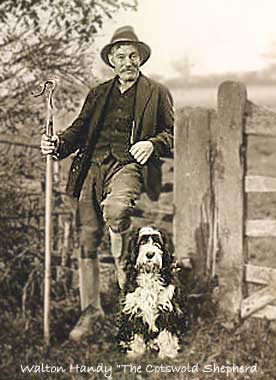 Left, Walter Walton Handy, "The Cotswold Shepherd", and his Old English Sheepdog, Shep.
Left, Walter Walton Handy, "The Cotswold Shepherd", and his Old English Sheepdog, Shep.
Below, right, the Royal Dalton dinnerware series of "The Cotswold Shepherd".
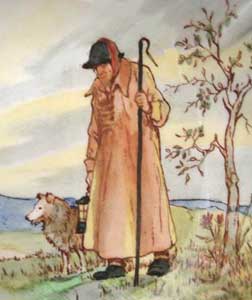 Before we leave the Old English Sheepdog, we would like to mention Walter Walton Handy (1870-1951). In 1934, the BBC chose Cotswold shepherd, Walter Walton Handy from Ilmington, Warwickshire, who was then 64 years old, to appear on the King's (George V) Christmas Broadcast to the Empire. Mr. Handy spoke in his soft country accent of his father, the simple ways of the past, the fast disappearing life of the shepherd. It was so well received that Mr. Handy was asked to repeat his performance in 1939 (for George VI). He became known as "The Cotswold Shepherd", and famous within his own community and beyond. The local newspapers featured stories about Mr. Handy, and published his photograph, with his dog, Shep. Royal Dalton even produced a series of dinnerware called "The Cotswold Shepherd", although it showed Mr. Handy (who looked pretty natty in his "modern countryman" suit, left) in an anachronistic "costume" of immensely long smock, and represented Shep as a collie.
Before we leave the Old English Sheepdog, we would like to mention Walter Walton Handy (1870-1951). In 1934, the BBC chose Cotswold shepherd, Walter Walton Handy from Ilmington, Warwickshire, who was then 64 years old, to appear on the King's (George V) Christmas Broadcast to the Empire. Mr. Handy spoke in his soft country accent of his father, the simple ways of the past, the fast disappearing life of the shepherd. It was so well received that Mr. Handy was asked to repeat his performance in 1939 (for George VI). He became known as "The Cotswold Shepherd", and famous within his own community and beyond. The local newspapers featured stories about Mr. Handy, and published his photograph, with his dog, Shep. Royal Dalton even produced a series of dinnerware called "The Cotswold Shepherd", although it showed Mr. Handy (who looked pretty natty in his "modern countryman" suit, left) in an anachronistic "costume" of immensely long smock, and represented Shep as a collie.
Copyright © 2013 by Carole L. Presberg
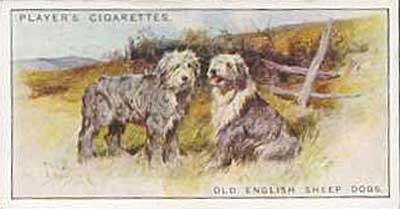
More information on the Old English Sheepdog.
Return to
![]()
BORDER COLLIE COUSINS
THE OTHER WEB PAGES WE MAINTAIN
These web pages are copyright ©2013
and maintained by webmeistress Carole Presberg
with technical help from webwizard David Presberg
ALL RIGHTS RESERVED
If you are interested in using ANY material on this website, you MUST first ask for permission.